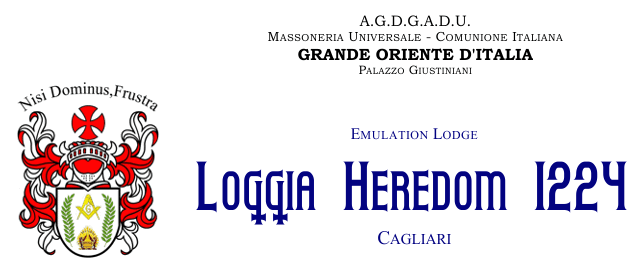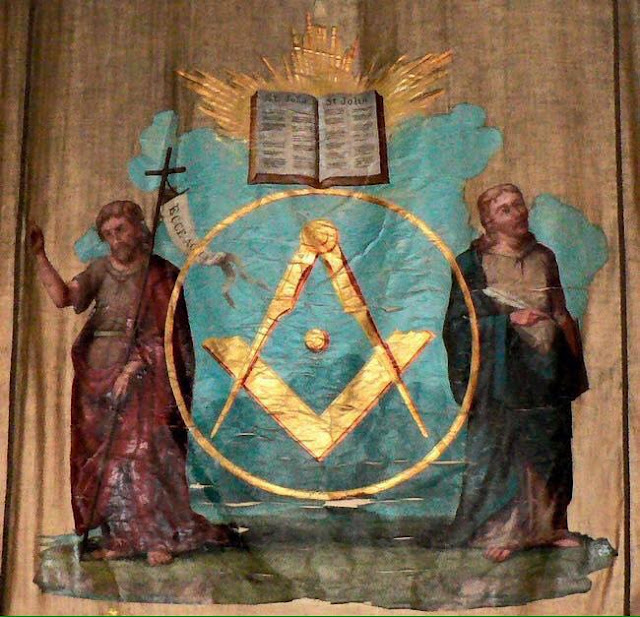The Scottish Reformation of 1559-60 swept away the Roman Catholic form of Christianity and ushered in was the new Protestant religion, which had a very different view of how God was to be worshipped. Gone was the Catholic form of worship (particularly the Mass), images of saints, Catholic symbols and other church paraphernalia. That which replaced it was quite different; simpler, plainer and all this took place within the lifetime of William Schaw (1550 - 1602) and his now famous statutes (1598 and 1599). He is the man who many now acknowledge to the Father of Modern Freemasonry for it was he who began the process which led to Freemasonry as we know it today.
Many Lodges are named after a particular saint (St John is by far the most common, but there are many others ranging from St. Abb to St. Vincent included many Celtic saints) and we frequently hear general references to ‘the’ Saints John within Freemasonry. Some might be familiar with the symbol of the point within a circle, supported (to the right and left) by two parallel lines (see image).
If, however, Scotland's religion was so completely changed by the Reformation why do signs of the previous faith still linger within the modern Scottish Craft by reference to various saints?
Why are these two saints, St John the Baptist and St John the Evangelist, are regularly referred within Freemasonry? Answering these questions is the purpose of this short paper.
However, it is not the religious faith or the theological aspect that are for discussion here (that is for another time). It should always be remembered that the events of the Reformation created enormous and numerous changes within Scottish society. Bearing that in mind we will be better able to understand why saints remain part of Freemasonry today.
The Edinburgh Register House MS (1696) is the oldest known Masonic 'ritual' in the world, and it is unequivocally Scottish. That is clear from the rhetoric, spelling and syntax etc. This ritual and others very similar to it, the Airlie MS (1705) and the Chetwode Crawley MS (c.1710) are also Scottish and these have been described and analysed elsewhere (see for example The Airlie MS in Vol. 117 of AQC – the annual journal of Lodge Quatuor Coronati, No.2076).
The first mention of a Saint John, and I shall reveal which one in a moment, is contained within the obligation (which is in itself significant) these earliest of rituals. Part of the obligation reads call on. "I swear by St John, and the square and compasses.’ This means that 140 years after the Reformation (1559 - 60), Saint John was still being ‘sworn by’ Scottish stonemasons during their ceremonies and that the saint was on a par with the Square and Compasses.’
Before discussing why St John's Freemasonry is described as such I wish to turn to our pre-Reformation forbears to try and understand what they were doing and what part, if any, St John played in their activities.
In the middle ages most trade(s), especially those with some economic power were able to form guilds (in the Scotland they were usually known as Incorporations). Without going into a lot detail, trades such as Baxters (bakers), Wobsters (weavers) etc. were allowed to participate to a limited extent in a town's political activities. Although they had little real power they at least they had a voice, no matter how small, within the town's political establishment. This was useful to them when matters relating to their craft, stonemasonry, were debated. For example, the incorporation would negotiate working hours and wages and other conditions of employment. In return for the small amount of political representation the incorporations had, in return, to agree to accept certain responsibilities. For example, they had had to agree to control their prentices (apprentices), and had to agree and accept responsibility for improving their member's morals.
The pre-Reformation church had played a much bigger part in people's lives. The day was structured around the timing of church rituals, holy days etc. It was common for groups such as merchants combine to pay for the upkeep of part (occasionally all) of a particular church. Rich individuals occasionally took sole responsibility for a particular place in a church. These ‘particular parts’ of a church were usually side aisles dedicated to a saint where prayers would be offered to that particular saint for the souls of deceased family members.
When stonemasons attained the status of an incorporation, in Edinburgh, in 1475, they were given the responsibility for maintaining the aisle of Saint John the Evangelist within the St Giles, Cathedral. This meant that they had to keep the aisle clean and tidy, in good order, repair any damage and make regular donations of candle wax (which, of course, was used every day and was therefore expensive over the course of a year). In other words they met there regularly not only to hear prayers said for the souls of deceased stonemasons (The Mass) but also took the opportunity to discuss what was going on within the Craft.
It naturally followed that because the aisle was dedicated to Saint John the Evangelist whose feast day is the 27th December that was when most, if not all, the stonemasons would gather together. It was sensible therefore to use the period after the religious ceremonies had been completed that they conducted business – settle accounts, plan for the future, suggest changes in rules and practice, and most importantly initiate Prentices and make Fellow Crafts. The 27th December remains, the principal day in the calendar of Scottish Freemasonry (with the exception of St Andrew, 30th November – see below). It is for this reason today, that most Scottish Lodges continue to celebrate the 27th December and not the 24th of June (the feast day of Saint the Baptist) After the Reformation, many of the religious elements relating to saints, including aisles dedicated to them were abolished and that meant that stonemasons were no longer required to maintain ‘their’ aisle within St Giles Cathedral or other churches. However, they still required to conduct their annual business and simply continued to hold their ‘AGM’ on 27th December each year. This process can be seen from written records (including those of Edinburgh City Council for example), where this date is recorded as a meeting date of stonemasons both before and after the Reformation.
Once William Schaw (c.1550 – 1602), the Father of Modern Freemasonry, reorganised Scottish Lodges, those 'reorganised' Lodge’s records show that the 27th December continued to be their principal annual meeting. We now call these meetings ‘installations’ (usually on or about 27th December) because this is when the new Master is installed.
It is clear that St John the Evangelist was the patron saint of Scottish stonemasons but the question remains as to why he was chosen. The possible religious and theological reasons might be the subject of a later discussion but the thought does occur to the author that there is a very simple explanation. That is, when stonemasons became an incorporation the next available, or even the only available, aisle was that of St John the Evangelist! If this is true, as seems likely, then it was the church which ‘allocated’ this saint to them rather than the incorporation chose him as their Patron Saint.
What then of St John the Baptist and St Andrew, both of whom figure albeit not so prominently within Scottish Freemasonry? When the grand Lodge of England was established in the 1717 it was known that ‘St John’ was ‘the’ Patron Saint. There was no doubt about this but there was doubt as to which St. John – the Evangelist or the Baptist? When setting up a new organisation, such as the Grand Lodge of England and there is a choice between a day in the depths of winter, when the days are dark, short, very cold and often wet, or a day in the middle of summer, with warm days and long hours of sunlight, which day would you choose? Our English brethren may have simply automatically assumed that no one would be crazy enough to chose the 27th December. Or, if they did know that Scotland used the feast day of St John the Evangelist, they ‘turned a Nelson eye’ to that inconvenient fact and chose the of the Saint John the Baptist whose feast day is at the height of summer - 24th of June annually.
When Lodges in Edinburgh decided that Scotland should also have its own Grand Lodge they paid particular attention to the procedures used to establish the formation of the Grand Lodge in London, and also adopted (one could believe almost without thinking because the were simply copying a previous example) St John the Baptist Day as their main feast day. Unfortunately, those organising this new body, the Grand Lodge of Scotland, had not taken into account the traditions of Scottish stonemasons, including their Patron Saint - John the Evangelist. The main effect of this was that the majority of stonemasons’ lodges in Scotland did not take part in the formation of the new Grand Lodge as they believed it would be quite wrong to overturn centuries of tradition and adopt a new Patron Saint and one that seemed to have been chosen for them by copying English Masons.
The new Grand Lodge of Scotland had got itself into a real pickle. If it persisted with St John the Baptist Day on which to hold its main annual meeting and installation of the Grand Master Mason it would offend all the stonemasons' lodges. If it adopted John the Evangelist it would offend all the speculative Lodges (the majority).which had been so involved in organising and supported its' creation from the beginning. In other words whichever Saint John it chose, it was going to upset one group or another. In a typical Scottish pragmatic move a compromise was reached – it adopted neither John the Evangelist nor John the Baptist and opted instead for the Patron Saint of Scotland. This is why therefore that although Scottish Craft Freemasonry is known as John’s Freemasonry the Grand Lodge of Scotland uses neither. It is also why St Andrew’s feast day, 30th November, is the Grand Lodge of Scotland’s Installation and Festival of St Andrew.
Last but not least this is also why the symbol shown here (with or without the actual figures representing the Saints John) is not appropriate within Scottish Freemasonry.


